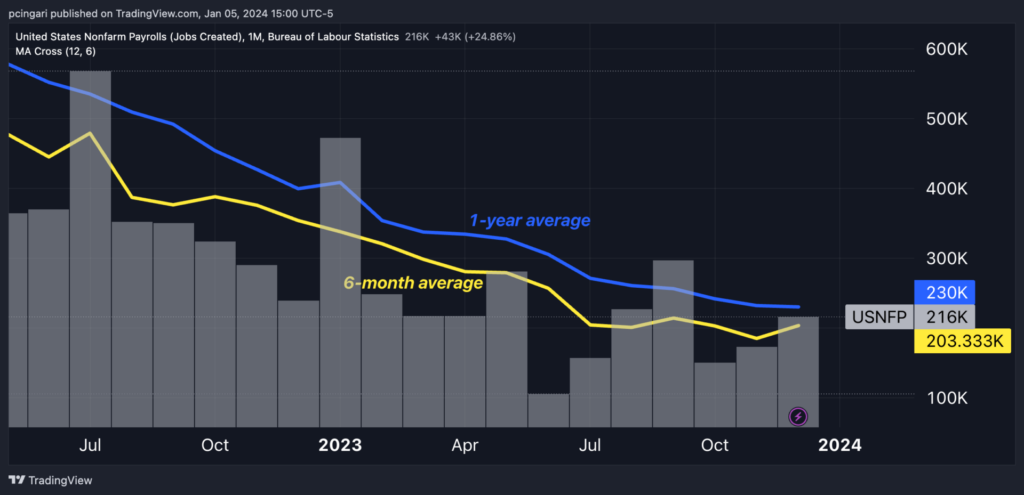Zinger Key Points
- December's jobs report shows a strong 216,000 non-farm payroll growth, surpassing expectations, with steady unemployment at 3.7%.
- Economists debate implications: labor market cooling, part-time job increase, inflation concerns and potential impact on Fed policies.
- Join Chris Capre on Sunday at 1 PM ET to learn the short-term trading strategy built for chaotic, tariff-driven markets—and how to spot fast-moving setups in real time.
The Bureau of Labor Statistics’ December jobs report released Friday generated varied reactions from economists and financial analysts.
With non-farm payrolls (NFPs) growing by 216,000 and surpassing expectations, wage growth advancing more than expected and unemployment holding steady at 3.7%, experts are decoding what this means for the economy and the markets.
Chart: Pace Of Job Creation Surges In December 2023

Michael Gapen, chief U.S. economist, Bank of America: Gapen observed a “gradual cooling in the labor market,” suggesting a trend towards a soft landing rather than a recession.
He noted, “Nonfarm payroll employment beat expectations with a 216,00 increase. However, there were net downward revisions of 71,000 to the prior two months.”
Gapen’s analysis pointed to a decrease in the three-month average change in nonfarm payrolls, indicating a slowdown in job growth.
Jeffrey Roach, chief economist, LPL Financial: Roach highlighted a concerning trend, stating, “The ratio of part-timers to full-timers spiked in December, now above the pre-pandemic rate.” He also pointed out the downward revisions in payroll gains, a sign of slowing economic growth.
However, Roach believed “the recent uptick in average hourly earnings is not enough for the Fed to alter its policy plans in the upcoming months.”
Chris Todd, CEO, UKG: Offering a more optimistic view, Todd said, “Employees still have the upper hand, and that advantage is here to stay for the foreseeable future.”
He emphasized the challenges for employers in the current labor market and noted “our real-time workforce activity data shows strength and consistency.” Todd's positive outlook is bolstered by moderating inflation and steady wages.
Chris Zaccarelli, chief investment officer, Independent Advisor Alliance: Zaccarelli expressed surprise at the job market’s resilience, saying, “The fact that 216,000 net jobs were added — shows that the labor market is still really hot.”
He warned that high average hourly earnings could add to inflationary pressures. Zaccarelli also believed a strong economy would lead to higher revenues and profits for companies, which in turn would bolster stock prices. According to Zaccarelli, calling the end of this bull market was highly exaggerated.
Jeremy Straub, CEO and chief investment officer, Coastal Wealth: Straub’s analysis suggested the robust jobs report could delay the Fed’s rate cuts. He stated, “Clearly, the economy is strong enough as of now to withstand the Fed's currently elevated interest rates.”
Straub expected the stock market to remain range-bound in the short term due to typical profit-taking after recent rallies.
Market reactions: Friday session saw U.S. Treasury yields moving higher with the 10-year benchmark reaching 4.05% yield. Longer-dated 30-year yields surged to 4.20%.
In response, bond-related ETFs took a hit. The popular iShares 20+ Year Treasury Bond ETF TLT tumbled 1%, while the US Treasury 10 Year Note ETF UTEN fell 0.4%.
Read Now: Interest Rates Unlikely To Fall Soon: Bond Guru Projects 10-Year Yields Spiking To 5.5% In 2024
Photo: Shutterstock
Edge Rankings
Price Trend
© 2025 Benzinga.com. Benzinga does not provide investment advice. All rights reserved.
Trade confidently with insights and alerts from analyst ratings, free reports and breaking news that affects the stocks you care about.